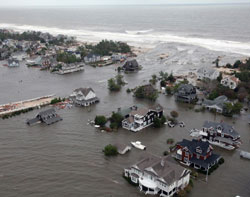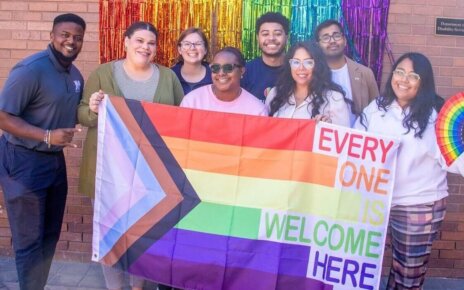Stonger Than The Storm: Superstorm Sandy One Year Later

One year ago on Oct. 29, Superstorm Sandy hit the east coast drastically affecting many lives and the University as a whole. Students, faculty members and residents up and down the Jersey shore suffered severe damage that many still face one-year later.
Ten-percent of New Jersey residents displaced from their homes during Superstorm Sandy have fully recovered, according to a poll conducted by the University polling institute on Oct. 21. The remaining 90 percent are still facing damages. The poll also stated that18 percent of families have moved back into their homes, and three-percent are still displaced.
The polling institute report stated, “Few of these families feel like they are close to full recovery and most feel that the state’s rebuilding efforts have overlooked them.”
“It’s awful,” said Lauren Payne, adjunct communication professor. “It’s horribly depressing,” she said while referring to the one year anniversary of Superstorm Sandy.
Payne’s home in Bayhead, NJ is one of the homes that has yet to begin the road to recovery. “…Everyone thinks it’s rebuilt, but there’s a whole community of us second floor dwellers and we are all in it together,” said Payne.
Payne describes second floor dwellers as people living on the second floor of their home while waiting on funds, a loan or help to rebuild the first floor.
Payne received four feet of water damage in the first floor of her home. “I am a block from the ocean and a block from Barnegat Bay, so I got water on both sides,” said Payne. “… [The storm] destroyed everything and washed the foundation right from underneath the house.”
Payne lost everything on the first floor, each piece of furniture, every appliance, book and photo. Her yard is filled with sand, a porta-potty is sitting in her front yard and a dumpster across the street while construction sites continue to surround her house, just as they did one year ago.
Jackie DiPasquale, junior communication major, was left to deal with similar circumstances. DiPasquale lives in Point Pleasant Beach, NJ. While packing to evacuate her home in October of 2012, she said she packed a few things, unaware of the damage that was to come. “We thought we would have been going home in a few days,” said DiPasquale. “It is unbelievable that those three days turned into what will be more than a year.”
 Upon returning to her home a few weeks after the storm, DiPasquale described the first floor as a nightmare. “…As soon as I walked inside, my life got turned upside down. Garbage cans were knocked over, furniture was moved, and trash was everywhere,” she said.
Upon returning to her home a few weeks after the storm, DiPasquale described the first floor as a nightmare. “…As soon as I walked inside, my life got turned upside down. Garbage cans were knocked over, furniture was moved, and trash was everywhere,” she said.
The family lost practically everything, said DiPasquale. “Hurricane Sandy has changed my family’s lives forever. Our home is the only home my little brother and I have ever lived in, and it is the house that my parents built together after they got married,” she said.
The damage to the home was due to the two and a half feet of water in the first floor and 45 inches that entered the garage. DiPasquale explained that the heartbreak continued when her family recognized that the attic fan had disappeared, and severe damage was caused to the roof allowing water to enter the second floor and create mold.
DiPasquale and her family are currently living with her grandparents while waiting for the home to be rebuilt. “It is truly unbelievable that it is officially the one year anniversary of Hurricane Sandy,” said DiPasquale. “The next few days are going to be tough on my family and I. I wouldn’t be surprised if I ended up crying.”
DiPasquale and Payne are only two of many families still facing damages from the superstorm in 2012. Not all families that received damage are living on their second floor, in a family member’s home, or shelter. University police officer, Bob McDonald, also a Point Pleasant Beach resident, received water damage in his home during the storm, although was able to quickly repair and return to resiliency.
“I had to replace the sheetrock, the floors, the appliances were ruined, the kitchen cabinets had to come out,” said McDonald. “A lot of work had to be done…” McDonald’s home reached a livable condition by Christmas of 2012. The family lived on the second floor for some time, although no persistent damage occurred.
Katie Meyer, graduate student, also suffered damage, although it was not due to water obstruction, but high winds. “Right before Hurricane Sandy really hit, the wind was so strong that two trees fell,” said Meyer. One tree fell on the family get-away car, and the other fell on home, crushing the attic.
Meyer explained that during the storm a total of 12 trees ended up falling on her property alone. According to Meyer the car was totaled and the attic took six months to replace. “Really, we were lucky. That was the only damage. All the other trees that fell landed in the yard. It could have been worse,” said Meyer.
Damage to the local area of the University was also severe. Alyssia Rodriguez, Oceanport, resident, five minutes from the University, is living in Fort Monmouth in Eatontown after her home flooded by the Shrewsbury River.
 Rodriguez and her family are waiting on Federal Emergency Management Agency (FEMA) and their insurance company to provide funds to just begin the rebuilding process. “There was so much damage that when FEMA came to access our house they considered it condemned which meant it was over 95 percent damaged and destroyed and it was unlivable,” said Rodriguez.
Rodriguez and her family are waiting on Federal Emergency Management Agency (FEMA) and their insurance company to provide funds to just begin the rebuilding process. “There was so much damage that when FEMA came to access our house they considered it condemned which meant it was over 95 percent damaged and destroyed and it was unlivable,” said Rodriguez.
The home was a few feet from the river and was the lowest and oldest house on the street, according to Rodriguez. The water obstruction reached a height of over seven feet, causing living conditions to be unthinkable. “It affected my family in an extremely negative way, we were misplaced and basically homeless for a while,” said Rodriguez.
In the local area, many residents were left without a place to stay after the storm. Many found themselves seeking shelter at the multi-purpose activity center (MAC).
President Dr. Paul Brown, said, “Monmouth University students and employees really came together during and after Sandy to help each other and their neighbors. The MAC served as the largest evacuation center in the New Jersey.”
The University housed over 1,100 evacuees that were left homeless. “I think the University made a big difference in providing safety and shelter to those in need, not only locally, but from a state wide viewpoint as well,” said Bill McElrath, Chief of the University Police Department said.
Though recovery is in sight, the damage still plays an essential role in many family’s lives. “It is still a very long road back to normal for us,” said Gina Columbus, University alumnus. “My home is gone and a new one is in the works. At some point every day, Sandy’s aftermath still affects my family and I a year later.”
Columbus added that she is very frustrated that the recovery of her home, which received four feet of water damage from the Metedeconk River, has still not been completed. “Knowing it’s the anniversary just makes me shudder and takes me back to that night,” said Columbus.
This past year has been a rollercoaster and the one-year anniversary is shocking and painful to most, although some were able to discover a type of silver lining along their journey. Payne explained that she is now known as a hugger. “My kids laugh at me because … I was never a hugger before, but now anyone I see that was affected by Hurricane Sandy, we all just hug each other.” Payne believes that the experience has allowed everyone to come together, as an “emotional connected community.”
Like many, Meyer was surprised by the support of her family, friends and even strangers. “It’s refreshing to see people care and give to others,” said Meyer. “There are so many reports of shootings and deaths, that a little neighborly love is nice.”
DiPasquale explains that through her experience, she has adopted new life lessons. “I have become so much stronger through this year, and am continuing to do so,” said DiPasquale. “This year has brought my family so much closer, and I didn’t think it was possible to be any closer than we already were.”
DiPasquale also received help from friends and family. She explained that though it is still a year later, friends and family continue to ask if the family needs any help. “It’s very nice to see that people are still considerate of those who still aren’t home after Hurricane Sandy.”
For some, the impact of the storm was due to a family member’s damages. Donna Dolphin, associate communication professor, lost a very important family home that was previously owned by her grandparents, inherited by her aunt.
The house was located in Lanoka Harbor in Lacey Township. Dolphin explained the area as a lagoon community. After the storm hit, and the water went down, Dolphin and her family went in and began to remove furniture, appliances and everything else from the house. The home appeared to be fixable, although the ground dried up and began to crack, leaving the family with no other option than to tear it down.
Dolphin’s silver lining was the discovery of a very valuable piece of the home that her son found while gutting the home. “There was a closet in the house that my grandmother had always used as she would write phone numbers and recipes,” said Dolphin.
Days before the home was torn down, Dolphin and her husband cut out the piece of sheetrock from the home, which she continues to hold as a memorandum of the many memories and meaning that was created in the home.
Dolphin and her family are in the process of trying to rebuild, although, like many other Sandy victims, money is the biggest issue.
DiPasquale’s home received over $200,000 worth of damages, although only received $91,000 from the insurance company. The family is now forced to rebuild using out-of-pocket money.
DiPasquale is just one of the many families waiting on insurance and government or state funding to allow them to rebuild. Her and her family anticipate to return home December 2013. “All I hope for is that my family and I can spend Christmas in our home; it would be the best Christmas present for us to receive,” she said.
The polling institute report found that 43 percent of the most-impacted residents hope to be fully recovered by October 2014. Thirty-one percent of these residents said it will take longer than that, and 16 percent said they will never recover.
Though the damage is still among New Jersey residents, there is a positive side that people have begun to acknowledge. McElrath said, “Having gone through this experience, everyone came out smarter and will be better able to prepare for any future storms.
“Although it made me a little crazy and very stressed at times, in the end literally what doesn’t kill you, makes you stronger,” said Columbus.
PHOTO TAKEN from onedayinamerica.blogspot.com
IMAGES TAKEN from NYDailyNews.com


